Another book from my students’ projects, this one with a curious binding:
At first glance, what you might see is an armorial binding: a binding in which an owner has stamped his arms in gold tooling. No big deal, really; there are plenty of books like those in libraries. But this one is more complicated: there are TWO coats of arms, one stamped on top of the other. Here’s a close-up of the center of the binding, where the arms are:
And the supporter on the left looks like a horse:
I can’t make out the details of the arms themselves, but you can see the motto on which the supporters are standing:
My student deciphered it as “fidei coticula crux” and that looks right to me.
If you look closely at that last picture, you can see that the arms with the supporters and motto was done second: its lines cross on top of the other arms. And if you look at the original arms, you might recognize them as James I’s arms: there’s the harp on the bottom left of the shield, the lions and fleur-de-lis quartering the right, and the motto “honi soit qui mal y pense” circling the shield. (This gives you some sense of the arms, though that harp is a bit excessive.) (And I should point out, although it’s surely obvious by this point, that I’m not particularly knowledgeable about arms and that my vocabulary choices might not be quite precise. But this is why we need help.)
So whose coat of arms is on top of James’s? Is it possible it’s James’s favorite, George Villiers, aka the first Duke of Buckingham? According to the Burke I was looking at, not only was the family’s motto “Fidei coticula crux”, but he used the supporters of “a dapple grey horse” and a stag. But, as I said, I’m not super confident of my ability to deal with armorial and geneological crap, so does someone want to confirm or deny this? I’m drawn to it because if someone WAS going to stamp their arms on top of the king’s, wouldn’t it be great if it was him? (If you’re not familiar with this period, you might want to know more about Villiers; this link should, I hope, get you into the Oxford Dictionary of National Biography‘s article on him for the next few days [though April 27th]. If it no longer works, well, this would be a good time for you to do some scouting about on your own! If you know of some reliable open access information about him, please leave it in the comments. Or go edit the Wikipedia page, which could use improvement!)
I should say something about what book this is, I suppose. It’s John Smith’s 1624 The generall historie of Virginia, New-England, and the Summer Isles. It’s a very interesting book, and there’s some great marginalia in it, but that will have to wait until another post, especially since my student is still in the middle of her research! But the arms thing is tricky to decipher and the Folger catalog record identifies only one of the two crests (James’s, of course), so I wanted to lend her a hand in getting it sorted out. And I certainly didn’t want to lead her astray with my desire for it to be Buckingham! So please leave me a note telling me what you think and I’ll pass it on to her.

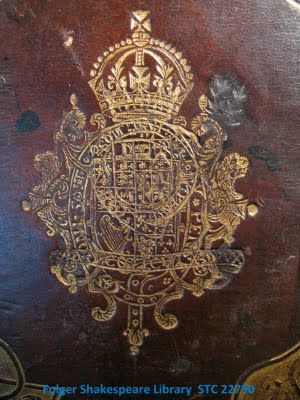
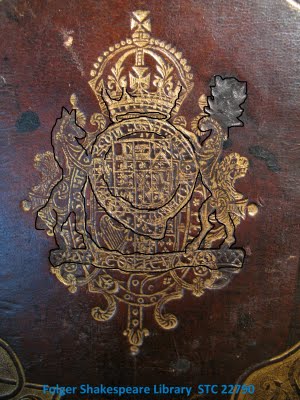
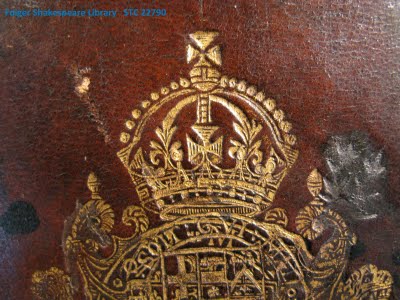
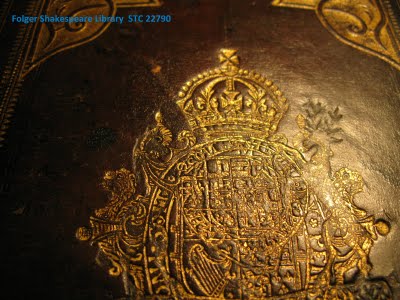
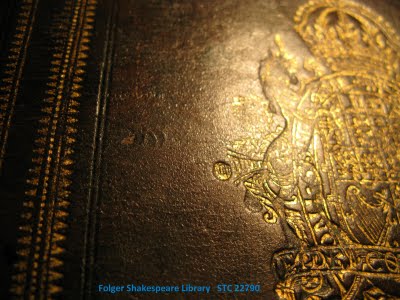

>If you're curious, you can see two examples of James's arms on some bindings in the collection of St Johns College, Cambridge:http://www.joh.cam.ac.uk/library/special_collections/early_books/pix/provenance/james/james.htm
>Buckingham's arms described here:http://goo.gl/CKaZD and you can see a version of them here on the Watergate in London http://goo.gl/RDkoTThis might also be worth looking up in a library http://goo.gl/WKo0cThis looks interesting though – from his memorial Portsmouth Cathedral http://i10.photobucket.com/albums/a103/plowmans/Pompey/buckingham.jpgIt looks like something busy like that could be hiding underneath
>Thanks, Louise. That description you found of Buckingham's arms is from the Burke I mention in the post, so at least we haven't yet turned up any contradictions! Now that I'm in the library today, I can do a bit scouting with some other resources. I can't for the life of me figure out what's on the shield itself, which is frustrating–but not totally disabling, I hope!
Hi, I’ve just stumbled across your blog. I have an interest in heraldry, though am no expert. Your student is probably finished by now, but this is an interesting puzzle.
I think you are probably right about the arms belonging to George Villers, 1st Duke of Buckingham. The supporters, motto and more importantly the arms match (there’s an image of them here , taken from the bottom of this page.
Interesting however is the coronet on top of the shield. Although obscured by the crown from James I’s arms, it appears to consist of alternating strawberry leaves and pearls, which corresponds to the rank of Marquess (see illustrations e.g. http://en.wikipedia.org/wiki/Coronet , though minus the red cloth). If this is indeed the case it would strengthen your identification; George Villiers was Marquess of Buckingham from 1617/8 to 1623 (and no other Villiers reached this rank). As the book was published in 1624, perhaps he hadn’t got around to commissioning a new die for the stamp.
One reason Villiers might have received a copy of the book was that he was a member of the Plymouth Council for New England (see e.g. this charter